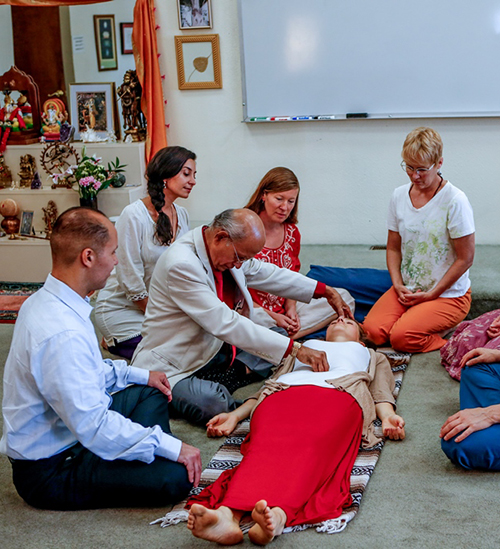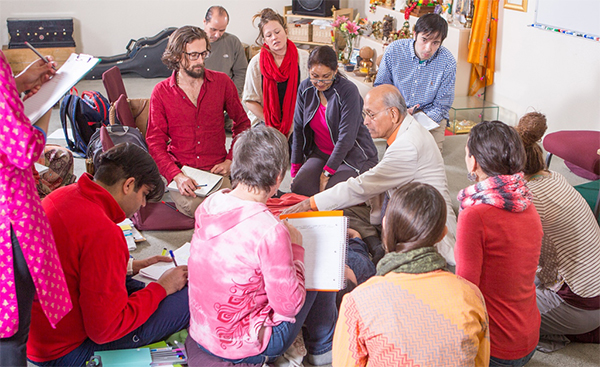
8. Pulse diagnosis is very important in Ayurveda. This means checking and listening to the pulse on the wrist and making the diagnosis. You are known to be a real master of this. You wrote the most comprehensive book regarding this matter, and you are also known to identify people’s state of consciousness by checking the temples. Can everyone get pulse diagnosis training? Is everyone capable of learning this very special examination method? Or does it require some spiritual support?
Any person who is sincere and learns the technique can learn pulse diagnosis.
Once a person learns the technique, they can master the pulse. There is no profound spiritual support required. But I do think that person should do pranayama. When a person does pranayama, especially anuloma viloma, the tips of the fingers become sensitive. They are like electrodes, sensors of the pulse. These sensors become more sensitive by doing certain mudras and breathing exercises. At The Ayurvedic Institute every summer, we have our one week Pulse Intensive to learn and practice the art of pulse diagnosis. Those who really want to study the pulse can attend this workshop and, I assure you, they will learn pulse analysis.
9. The process of disease is explained in six stages in Ayurvedic Medicine. What is the earliest stage a disease can be detected through pulse diagnosis? Why can’t western medicine detect these initial stages of the diseases?
The initial stage of the disease is called sanchaya prakopa. Sanchaya means accumulation; accumulation of vata in the colon, of pitta in the intestine, and of kapha in the stomach.
Sanchaya means accumulation; accumulation of vata in the colon, of pitta in the intestine, and of kapha in the stomach. In pulse diagnosis, the organ pulse will indicate the condition of accumulation. If the colon pulse is feeble and there is a vata spike that means that gas is accumulated in the colon. Likewise, the stomach is the seat of kapha and, when the stomach pulse is feeble and when there is a kapha spike, kapha is overloaded in the stomach. This is how organ pulse reveals the earliest stage of disease.
The ancient wisdom of Ayurveda can tell us the disease process before prodromal symptoms occur. That is one value of the great skill of pulse diagnosis. Modern medicine focuses on symptomatology and then pathology. They search for pathophysiological changes that take place in the heart, lungs, kidneys, and brain. In modern medicine, they don’t yet have any sensitive instruments that can detect these first two stages of the disease. I hope in the near future they will discover some instrument to detect the disease process before it forms.

10. What is your advice in terms of meditation? Is it the mantra meditation? Or the Buddhist mindful meditation that is more beneficial? Which path do you recommend to follow after the So Hum meditation in terms of advanced meditation techniques? What is the importance of power of intention prior to meditation?
The power of intention is very beautiful because intention gives you attention and attention becomes awareness.
I also love Buddhist mindfulness mediation, which is very profound. But in the beginning is difficult to be mindful. We can start with mantra meditation.
Mantra mediation is very powerful. You are a body. You physically sit in a closed room, maybe an empty room, and you repeat the mantra. When you repeat the mantra, loud enough so only you can listen, then your body is saying mantra. You repeat the mantra. Repeat the same mantra, over and over. Say “om, om, om…” and so on. Not om and a pause. When there is a gap, a pause, then the mind will become active. Just repeat the mantra continuously for ten minutes. You can intensely chant the mantra Ram, Ram, Ram, or Allah, Allah, Allah or Christ, Christ, Christ. What happens when you chant like this is the mantra vibration, its sound, travels to the wall, then rebounds and comes back to your body.
Thus physical, loud chanting cleanses the physical body for the first ten minutes of chanting. For the next ten minutes, sit quietly. Just feel the mantra. Let your mind chant the mantra. Chant the mantra without verbalization, then you are in the body and the mind is your home. The central part of your mind is repeating the mantra. The mantra now rebounds to the wall of the mind and comes back to the being, again and again.
For the third stage of the mantra, just sit quietly and witness the mantra. There you will see that all of your body cells are chanting the mantra; all the molecules of your mind are chanting the mantra and you are absolutely silent; you are witnessing. This witnessing awareness is mindfulness. To practice mindfulness quickly is difficult to attain, but it is easy to follow a mantra. Pick a short mantra. The om mantra is very powerful because om is a universal sound.
Mantra meditation is very powerful and anyone can do it. In its final stage, mantra meditation becomes silent and you transition into witnessing awareness. Then you are one with your being and your being is bliss, light, and love. That state can happen through mantra meditation. Mantra is the sound of the pathway of inner pharmacy; therefore, mantra meditation can heal.
So’Hum meditation is a very natural mantra. It is present in the breath. As you watch the breath, inhale So, then exhale Hum. As you continue breathing “So’Hum, So’Hum”, your grief, your sorrow will come to consciousness and it will dissolve into the outer space. So’Hum as a mantra will do purification of the body, mind, and consciousness. Between each inhalation and exhalation, there is a silent gap and in that gap, So’Hum becomes light. That silent gap is beyond time and merges into inner peace, inner bliss.
11. What would your advice be for people, such as me, who would like to be a good Ayurvedic specialist and would like to shed this light on themselves and their environments for being more healthy and happy and have a balanced life?
When you love humanity, out of that love comes compassion, and that compassion is passion for all.
Finally, to become an Ayurvedic specialist means to love every individual irrespective of caste, creed and color, to love everyone, irrespective of religion. When you love humanity, out of that love comes compassion, and that compassion is passion for all. Through that compassion, healing will happen. So God is love, God is compassion, and God is choiceless passive awareness. The whole environment of being is vibrant, full of light, clarity, purity and compassion of perception.
THE END